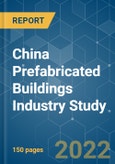The Prefabricated Building Market in China is expected to grow at a CAGR of approximately 5% during the forecast period. Rising concerns over the green infrastructure and sustainable living to accommodate the needs of the increasing population will be the main driving factor.
The revenue generated from the prefabricated buildings industry in the year 2016 amounted to USD 37.716 billion. In the year 2018, the value rose to USD 41.4 billion. China’s prefabricated market is expected to reach 698.2 billion in 2030.
In the past ten years, with the rapid development of the economy, the rising labor costs, the precision and quality of prefabricated components, the improvement of the construction technology and management level of assembly buildings, and the promotion of national policy factors, prefabricated buildings have gained momentum.
In its 13th Five-Year Plan, covering economic and social development from 2016 to 2020, in the cities with a permanent population of more than 3 million, the government planned for active promotion of prefabrication such that the share reaches around 15% and in other areas, the government plans to increase the share to 10%. As the concern on green buildings is increasing in China, the prefabricated construction methods are expected to gain momentum.
The government is planning to increase the proportion of prefabricated buildings in the new construction in three areas. The key promotion areas include the three major urban agglomerations of Beijing-Tianjin-Hebei, Yangtze River Delta and Pearl River Delta, where the country is looking to increase the share to around 20%.
Some of the factors that constrained the growth of the prefabrication buildings industry in China include high initial cost, high-cost pressure without appropriate economic scale effects, lack of regulations addressing prefabricated construction practices, and others. In the context of green construction in China, the prominence for prefabrication is increasing in the building construction sector in the nation.
Key Market Trends
Concrete Holds the Major Share in the Prefab Construction Sector
China’s urban landscape continues to evolve today, but unlike the earlier periods of urban development, with the influence of smarter global construction processes and methods. The growth of the building and construction industry as well as improvements in financial conditions in the region has led to an increase in demand for precast concrete elements.
With the precast construction market expected to attain USD 200 billion or an increase of 30% by 2025, China now has over 1,000 precast factories (with a design scale of 30,000m3) across the region, with 600 more in the pipeline. The explosive growth in cement production correlates with China’s economic expansion.
While industrialization and urbanization advanced in the country, the demand of cement rose sharply. According to the National Bureau of Statistics of China, the net output of the construction industry grew constantly in the previous decade. Houses, roads, and bridges had been built here with phenomenal speed over the past three decades.
Banking Reforms and Development of Economic Zones to Boost the Construction Activity in Prefab & Modular Sector
In China, the introduction of low lending rates and lax central housing policies, which can make loans easily available, is likely to boost the regional prefabricated buildings market growth. The labor cost associated with prefabricated buildings is considerably low in developing countries, such as India and China. Also, of the 5,400 special economic zones (SEZs) in the world, more than 4,000 are in developing countries in Asia. China hosts the most, at more than 2,500. Southeast Asian countries together host more than 700. South Asia hosts upward of 450 zones and West Asia’s tally surpasses 200. China’s continued policy experiment in large-area zones, investment facilitation measures, and relaxation of foreign ownership in sectors, such as finance and health care, in pilot free trade zones are expected to draw future investments. In recent years, the central government has successfully introduced relevant policies to promote green buildings and fabricated buildings, formulated industry guidelines, and set construction targets. In its 13th Five-Year Plan, covering economic and social development from 2016 to 2020, the need to promote prefabrication as part of the construction industrialization and green building action plan was announced by the Chinese government which proposed that 30 percent of newly-built buildings will be prefabricated by 2025.
Competitive Landscape
The report covers the major players operating in the China Prefabricated Buildings Industry. The market is highly competitive with a few players occupying the major share. The market is fragmented, and the market is expected to grow during the forecast period. Going forward, the prefabricated buildings industry in China is expected to remain stronger, with the formulated central government policy objectives. CIMC Modular building systems is one of the market leaders in the prefab sector in China.
Additional Benefits:
- The market estimate (ME) sheet in Excel format
- 3 months of analyst support
This product will be delivered within 2 business days.








